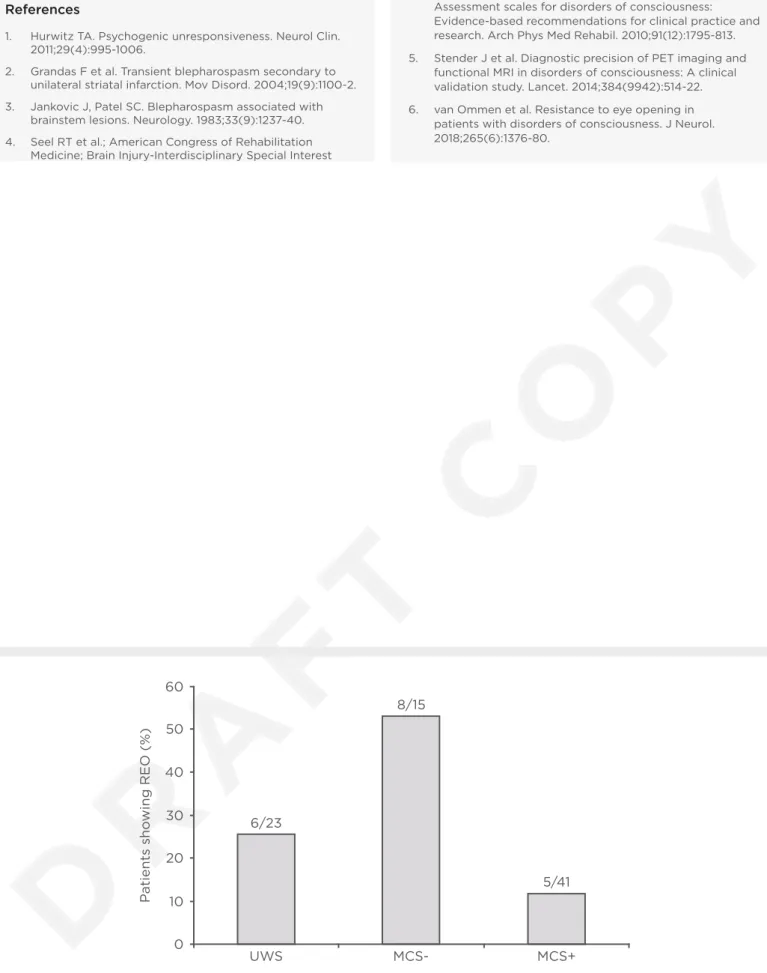Resistance to Eye
Opening in Patients
with Disorders of
Consciousness
Authors: Hjalmar Jochem van Ommen,
Aurore Thibaut, Steven Laureys, *Olivia Gosseries
GIGA-Consciousness, Coma Science Group; Neurology Department, University Hospital of Liège, University of Liège, Liege, Belgium
*Correspondence to ogosseries@uliege.be
Disclosure: The authors have declared no conflicts of interest.
Acknowledgements: The study was supported by the University and University Hospital of Liège, the Belgian National Funds for Scientific Research (FRS-FNRS), Human Brain Project (EU-H2020-fetfagship-hbp-sga1-ga720270), Luminous project (EU-H2020-fetopenga686764), the French Speaking Community Concerted Research Action (ARC-06/11-340), the James McDonnell Foundation, Mind Science Foundation, IAP research network P7/06 of the Belgian Government (Belgian Science Policy), the European Commission, the Public Utility Foundation ‘Université Européenne du Travail’, “Fondazione Europea di Ricerca Biomedica”, and the BIAL Foundation. Dr Thibaut and Dr Gosseries are post-doctoral fellows, and Dr Laureys is a research director at the FRS-FNRS. The authors would like to thank Prof Pierre Maquet from the Neurology department at the University Hospital of Liège, and all of the Neurology staff, patients, and their families at the hospital.
Keywords: Diagnosis, disorders of consciousness (DOC), minimally conscious state (MCS), resistance to eye opening (REO), sign of consciousness, unresponsive wakefulness syndrome (UWS).
Citation: EMJ Neurol. 2018;6[1]:XX-XX. Abstract Review No. ARXX.
Resistance to eye opening (REO) is defined as strong closure of already closed eyelids by a patient when they are touched by an examiner during ophthalmological examination. REO has been described in many different disorders, such as psychiatric coma, non-epileptic attacks, stroke, anoxia, and demyelinating illness.1-3
Explanations for this symptom range from wilful to reflexive. As empirical data regarding REO in severe brain-injury patients with chronic
disorders of consciousness (DOC) are missing, a trial was set up to investigate whether REO is a sign of consciousness or a reflex.
We selected 79 patients out of 150 consecutive patients in our centre with chronic unresponsive wakefulness syndrome (UWS), where the patients are awake but unaware, or patients who were in a minimally conscious state (MCS), during which the patients are awake with reproducible signs of consciousness, with (MCS+) or without (MSC-) language processing. Patients were behaviourally assessed daily for 1 week. We assessed a) the level of consciousness using the Coma Recovery Scale-Revised (CRS-R),4
which is currently considered to be the most accurate clinical measure of consciousness in patients with chronic DOC, b) the presence of REO, and c) the number of times that REO was seen in each patient (repeatability). Furthermore, most patients underwent positron emission tomography (PET)-CT scanning to measure cerebral metabolism. Brain images were then compared to healthy controls.5 A few
patients also underwent MRI scanning, during which they were instructed to perform mental imagery tasks.
REO was observed in 19 out of 79 patients (Figure 1). There was a significant relationship between the presence of REO and the level of consciousness. There was also a significant relationship between repeatability of REO between patients in UWS, MCS-, and MCS+. Five out of six patients with UWS that showed REO displayed neuroimaging results more compatible with the diagnosis of MCS. This atypical brain metabolism was seen more often in UWS patients with REO than without REO. In conclusion, in our patient population, REO was observed in one in four patients with chronic DOC. As REO was noted in UWS and MCS patients, identification of REO in a single patient cannot reliably distinguish between voluntary or reflex behaviour. However, at a group level, repeatability of REO was highest in patients in MCS+, suggesting a link between repeatability and the level of consciousness. Our findings therefore suggest a voluntary basis for REO when seen multiple times in a single patient, which stresses the need for multiple assessments in DOC patients.6
References
1. Hurwitz TA. Psychogenic unresponsiveness. Neurol Clin. 2011;29(4):995-1006.
2. Grandas F et al. Transient blepharospasm secondary to unilateral striatal infarction. Mov Disord. 2004;19(9):1100-2. 3. Jankovic J, Patel SC. Blepharospasm associated with
brainstem lesions. Neurology. 1983;33(9):1237-40. 4. Seel RT et al.; American Congress of Rehabilitation
Medicine; Brain Injury-Interdisciplinary Special Interest
Group; Disorders of Consciousness Task Force. Assessment scales for disorders of consciousness: Evidence-based recommendations for clinical practice and research. Arch Phys Med Rehabil. 2010;91(12):1795-813. 5. Stender J et al. Diagnostic precision of PET imaging and
functional MRI in disorders of consciousness: A clinical validation study. Lancet. 2014;384(9942):514-22. 6. van Ommen et al. Resistance to eye opening in
patients with disorders of consciousness. J Neurol. 2018;265(6):1376-80.
Figure 1: Percentage of unresponsive wakefulness syndrome patients and minimally conscious state patients with and without language processing who showed signs of resistance to eye opening.
MCS+: minimally conscious state with language processing; MCS-: minimally conscious state without language processing; REO: resistance to eye opening; UWS: unresponsive wakefulness syndrome.
P atients sho wing REO (%) UWS 6/23 MCS-8/15 MCS+ 5/41 60 50 40 30 20 10 0
